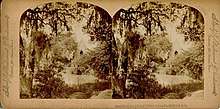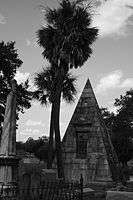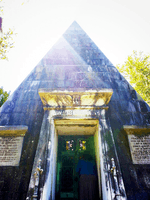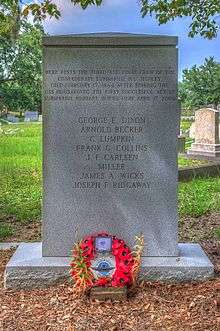Magnolia Cemetery (Charleston, South Carolina)
Magnolia Cemetery is a historic rural cemetery in Charleston, South Carolina.[2][3] The first board for the cemetery was assembled in 1849 with Edward C. Jones as the architect.[4] It was dedicated in 1850; Charles Fraser delivered the dedication address.[5] It was listed on the National Register of Historic Places as a Historic District in 1978.[1]
Magnolia Cemetery | |
.jpg) Vanderhorst Mausoleum | |
  | |
| Nearest city | Charleston, South Carolina |
|---|---|
| Coordinates | 32°49′6″N 79°56′32″W |
| Area | 92 acres (37 ha) |
| Built | 1850 |
| Architect | Edward C. Jones |
| NRHP reference No. | 78002502[1] |
| Added to NRHP | March 24, 1978 |

The location of the cemetery had previously been a plantation known as Magnolia Umbra, the house of which was described as a newly built house with five rooms in 1820.[6] The cemetery was constructed during 1850, on plans laid out by Edward C. Jones, and included a Gothic chapel also designed by Jones which no longer exists.[7] The chapel, which was located near the central lake, remained under construction until early 1851.[8] Both the chapel and the porter's lodge sustained very heavy damage during the cemetery's occupation by federal forces during the Civil War.[9][10] The porter's lodge at the entrance was demolished in 1868, but the chapel continued to be used until at least 1876.[11][12]
Notable interments
- William Aiken, Jr. (1806–1887), US Congressman, South Carolina Governor
- John Bennett (1865–1956), author and illustrator
- Thomas Bennett, Jr. (1781–1865), Governor of South Carolina
- William H. Brawley (1841–1916), U.S. Representative from South Carolina and United States federal judge
- Sallie F. Chapin (1830-1896), organized the Charleston Woman's Christian Temperance Union in 1881, the first in the state and served as first State president in 1883
- Langdon Cheves (1776–1857), American politician and a president of the Second Bank of the United States
- James Conner (general) (1829–1883), Confederate general in the American Civil War
- George E. Dixon (1837–1864), Commander of the Confederate submarine H.L. Hunley
- Frank Bunker Gilbreth, Jr. (1911–2001), author
- William J. Grayson (1788–1863), U.S. Representative from South Carolina
- Wilson Godfrey Harvey (1866–1932), Governor of South Carolina
- Daniel Elliott Huger (1779–1854), US Senator from South Carolina
- Horace Lawson Hunley (1823–1863), Confederate marine engineer, developer of early submarines
- Micah Jenkins (1835–1864), Confederate general
- Mitchell Campbell King (1815–1901), physician
- George Swinton Legaré (1869–1913), U.S. Representative from South Carolina
- Hugh S. Legaré (1797–1843), 16th U.S. Attorney General
- William Turner Logan (1874–1941), U.S. Representative from South Carolina
- Andrew Gordon Magrath (1813–1893), South Carolina Governor
- Burnet Rhett Maybank (1899–1954), US Senator, South Carolina Governor
- John Darlington Newcomer (1867–1931), American architect[13]
- Josephine Pinckney (1895–1957), novelist and poet
- St. Julien Ravenel (1819–1882), physician and chemist
- Robert Rhett (1869–1913), U.S. Representative and Senator from South Carolina
- Roswell S. Ripley (1823–1887), Confederate general
- William Gilmore Simms (1806–1870), poet, novelist and historian
- Charles Henry Simonton (1829–1904), Confederate Colonel and federal judge on 4th Circuit Court of Appeals
- Julius Waties Waring (1880–1968), United States federal judge linked to the American Civil Rights Movement.
- Richard Smith Whaley (1874–1951), U.S. Representative from South Carolina
- British war graves of five Royal Navy and Merchant Navy personnel of World War II.[14]
Gallery
 Magnolia Cemetery in Charleston, South Carolina
Magnolia Cemetery in Charleston, South Carolina Wm B Smith Monument, one of the most unusual and striking crypts at Magnolia Cemetery in Charleston, South Carolina
Wm B Smith Monument, one of the most unusual and striking crypts at Magnolia Cemetery in Charleston, South Carolina Unknown Confederate States Navy Markers
Unknown Confederate States Navy Markers H.L. Hunley Memorial Marker
H.L. Hunley Memorial Marker
References
- "National Register Information System". National Register of Historic Places. National Park Service. July 9, 2010.
- McNulty, Kappy; Nenie Dixon; Elias B. Bull (August 23, 1976). "Magnolia Cemetery" (PDF). National Register of Historic Places - Nomination and Inventory. Retrieved 11 June 2012.
- "Magnolia Cemetery, Charleston County (off U.S. Hwy. 52, Charleston vicinity)". National Register Properties in South Carolina. South Carolina Department of Archives and History. Retrieved 11 June 2012.
- . Charleston, South Carolina: Charleston Courier. January 1, 1850. p. 2. Missing or empty
|title=(help) - Alfred L. Brophy, "These Great and Beautiful Republics of the Dead": Public Constitutionalism and the Antebellum Cemetery
- City Gazette. Charleston, South Carolina. April 12, 1820. p. 1. Missing or empty
|title=(help) - "Magnolia Cemetery". Charleston Courier. Charleston, South Carolina. July 20, 1850. p. 2.
- "The Magnolia Cemetery". Charleston Courier. Charleston, South Carolina. January 18, 1851. p. 2.
- "A Visit to Magnolia". Daily News. Charleston, South Carolina. November 12, 1866. p. 2.
- Jacob N. Cardozo (1866). Reminiscences of Charleston. J. Walker.
- "The City of the Dead". News and Courier. May 9, 1876. p. 4.
- Mazyck, Arthur (1875). Guide to Charleston illustrated. Being a sketch of the history of Charleston, S. C. with some account of its present condition, with numerous engravings. Charleston, South Carolina: Walker, Evans & Cogswell. p. 118.
- "John D. Newcomer Found Dead at 64". Charleston News & Courier. December 31, 1931. p. 1. Retrieved September 2, 2012.
- CWGC Cemetery Report, details obtained from Casualty Record.
External links
| Wikimedia Commons has media related to Magnolia Cemetery (Charleston, South Carolina). |
- Magnolia Cemetery at Find A Grave

